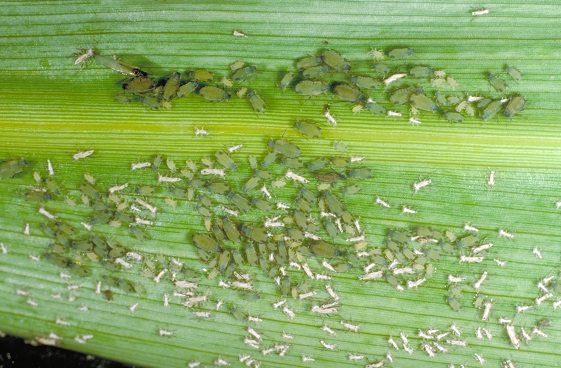Corn Leaf Aphid
ENTFACT-126: Corn Leaf Aphid | Download PDF
by Ric Bessin,Extension Specialist
University of Kentucky College of Agriculture
Corn leaf aphid is very common in whorl stage corn in Kentucky, but rarely causes economic losses. Infestations become apparent when the tassels begin to emerge revealing colonies of aphids. Infestations are more common in late-planted corn. Corn is most susceptible to yield loss by aphids while in the whorl stage. If large numbers are present three weeks before tassel emergence, physiological damage and some yield loss may occur. Corn may be stunted or wilted, especially when plants are under drought or nutritional stress. However, infestations usually occur close to tassel emergence, and despite large numbers of aphids, don't cause economic losses.
While infestations that cause physiological yield loss are uncommon, some producers feel that the large number of aphids and the honeydew they produce may interfere with pollination by gumming up the tassels. Excessive honeydew on the tassels may limit pollen shed and it has been associated with barren corn, although this is very uncommon. Silks that are covered in honeydew will continue to grow until they are pollinated.
Description
Corn leaf aphids vary from blue-green to gray and are small (1/8 inch or less), soft-bodied, and pear-shaped. They use piercing-sucking mouthparts to suck sap from the plant. A pair of tubes (cornicles) projects from the insect’s rear. Droplets of honeydew are expelled through the cornicles and deposited on leaves. Plant surfaces covered with honeydew may become moldy, giving the plants a black sooty appearance. Adults may or may not have wings. If wings are present they are clear, contain few veins, and are held roof-like over the body. Young aphids look just like adults except they are smaller.

Figure 1. Corn leaf aphid ca be very common beginning at the late whorl stage.
Biology
Corn leaf aphids are not cold hardy; whether or not they can overwinter in Kentucky USA is debatable. What is known is that the winged form of this aphid moves up from southern states each spring. In the spring, they move to weedy hosts such as johnsongrass, crabgrass and barnyard grass. Females give birth to live young and multiply rapidly. While most remain wingless when becoming adults, some develop wings at maturity. Winged individuals fly off and establish new colonies while the wingless individuals walk short distances and establish new colonies or remain in the parent colony.
Infestation in corn begins about four weeks prior to tasseling and continues through tasseling. Colonies are formed in the curl of leaves, in the whorl or on unemerged tassels. Aphid populations quickly decline after tassel emergence due to exposure to natural enemies and movement of winged individuals to later corn plantings or other hosts. Many of the aphids in these colonies may be discolored brown or golden; these aphids are infected with fungi or parasitized by small wasps. Generations occur about every 10 days during the summer.
Management
Growers need to monitor for corn leaf aphid twice prior to tasseling. This should be done 3 weeks prior to tassel emergence and again one week later. Four consecutive plants should be randomly selected in each of five locations per field. Carefully pull the whorl leaves from these plants, unroll the leaves, and estimate the number of aphids. Do not include off-color aphids (those that are diseased or parasitized) in these estimates.
Growers should consider treating for corn leaf aphids if an average of 15 or more aphids (10 with stressed plants) per whorl are found 3 weeks before tassel emergence or 30 or more aphids (15 with stressed plants) per whorl one week later. Closer to tassel emergence, greater numbers can be tolerated without loss of yield.
In tasseled corn, corn leaf aphids usually have done most of their damage and killing them often provides little savings to producers. There are few guidelines for making control decisions for tasseling corn. However, if less than 50 percent of pollination has occurred, aphids and honeydew are covering tassels, and plants are stressed, an insecticide may be necessary to ensure adequate pollination. If tasseled corn is to be treated for corn leaf aphids, treatments need to be made within 48 hours of tassel emergence.
Revised: 11/19
CAUTION! Pesticide recommendations in this publication are registered for use in Kentucky, USA ONLY! The use of some products may not be legal in your state or country. Please check with your local county agent or regulatory official before using any pesticide mentioned in this publication.
Of course, ALWAYS READ AND FOLLOW LABEL DIRECTIONS FOR SAFE USE OF ANY PESTICIDE!
Photos courtesy Ric Bessin, University of Kentucky Entomology
